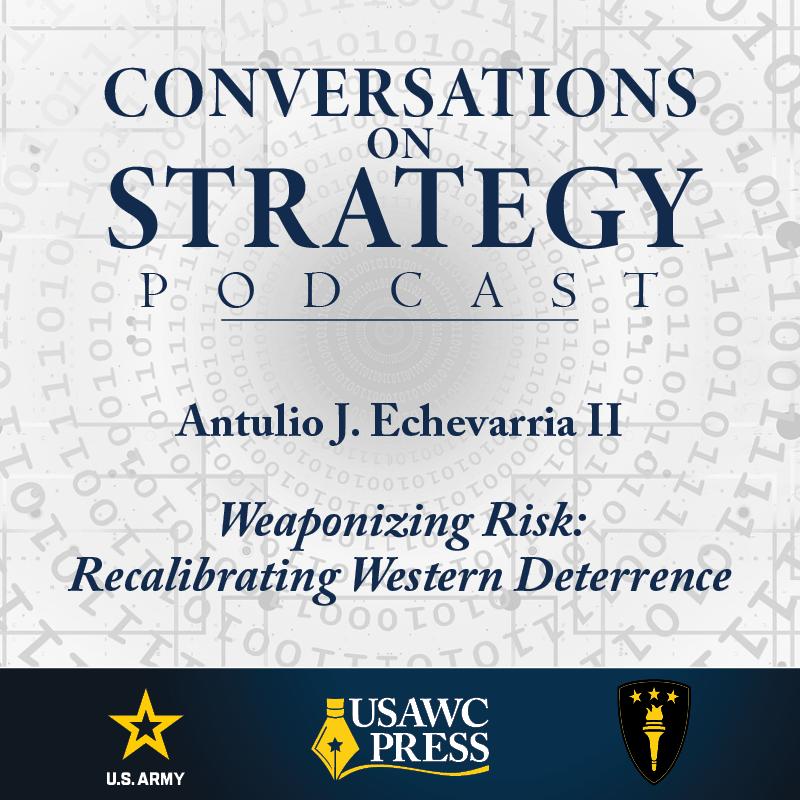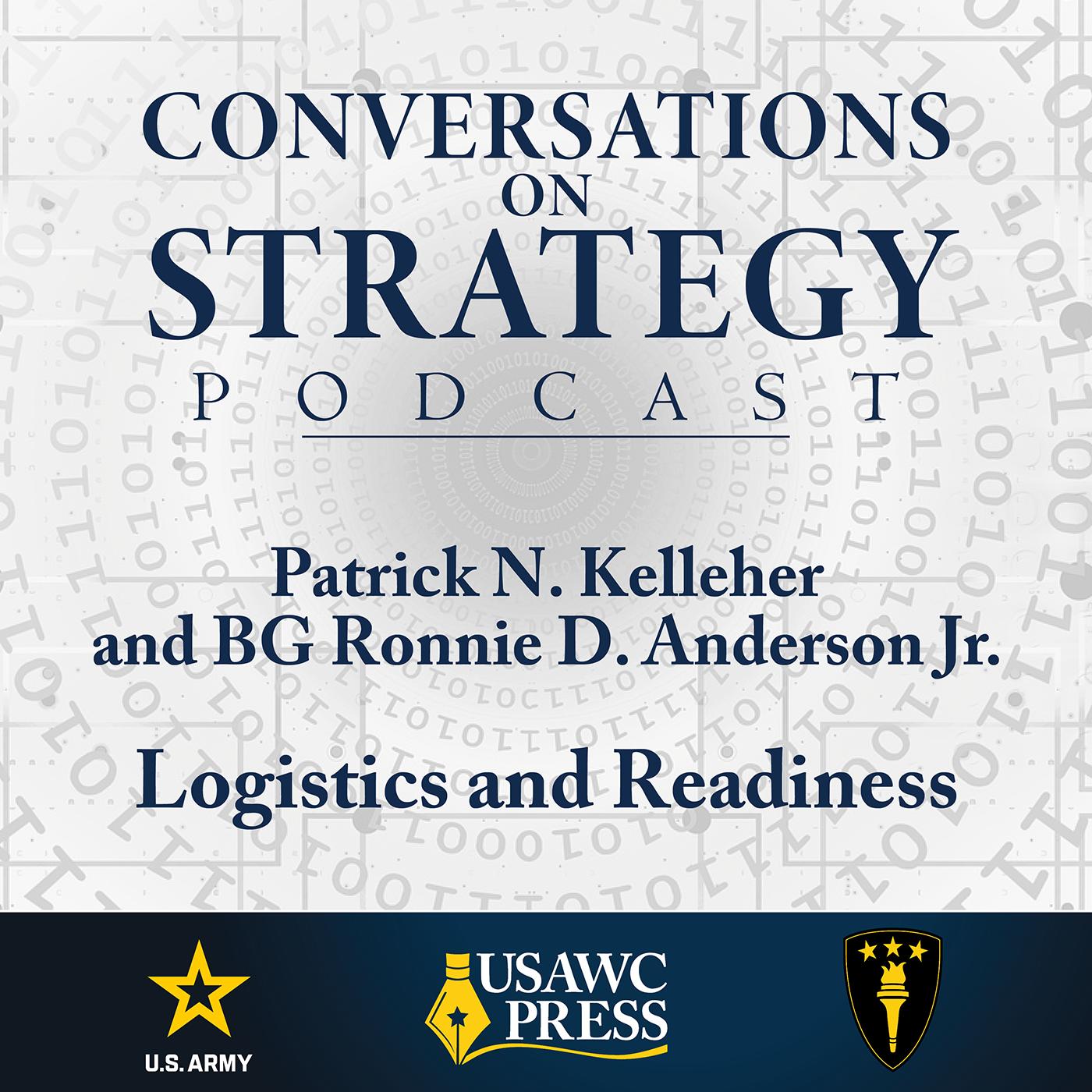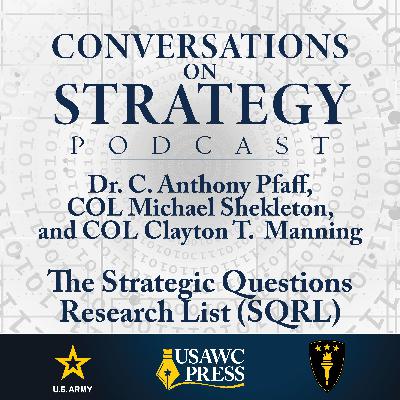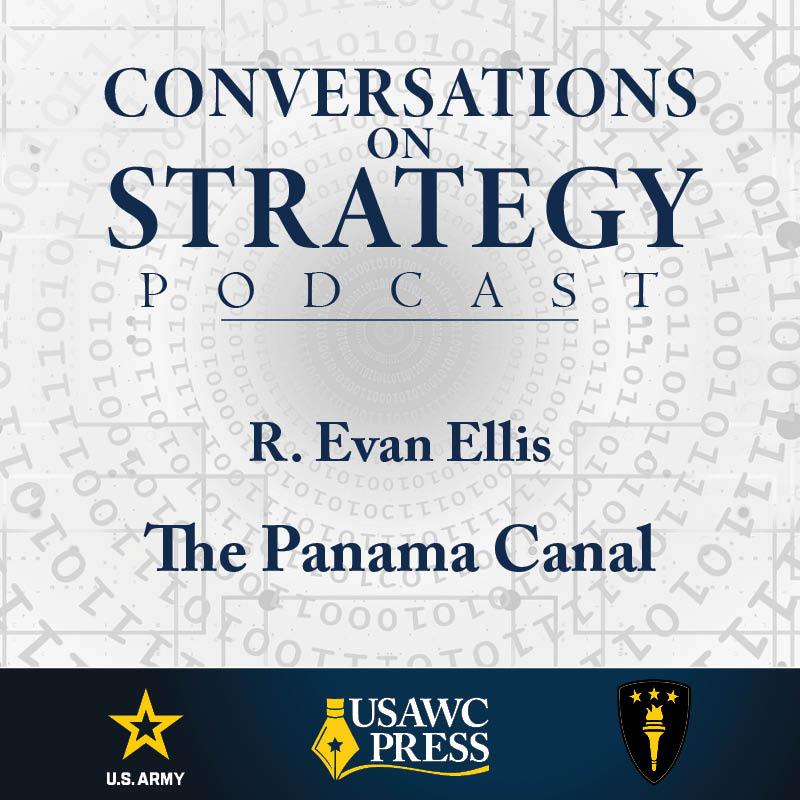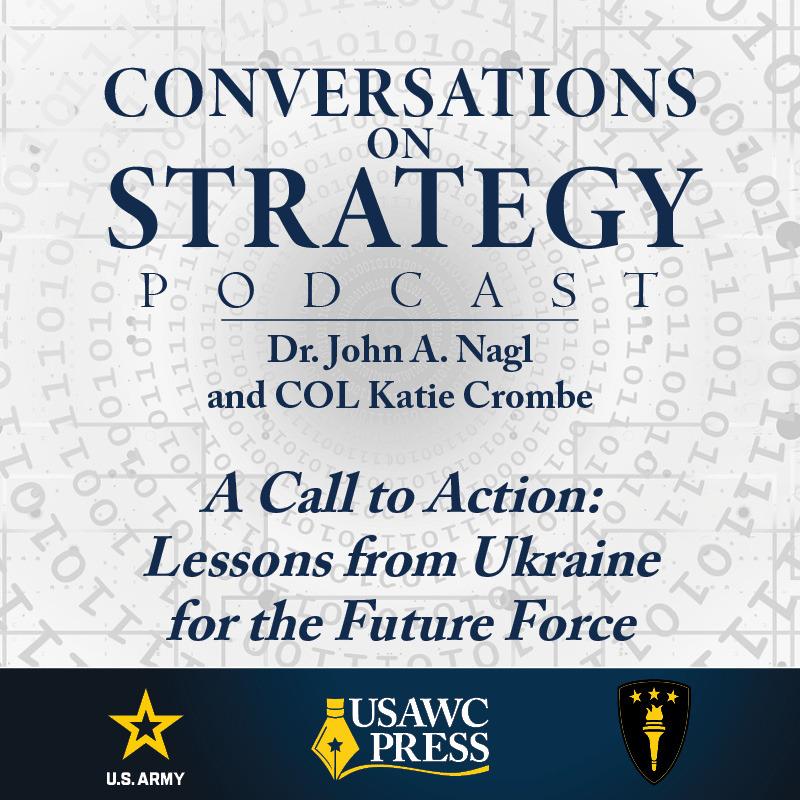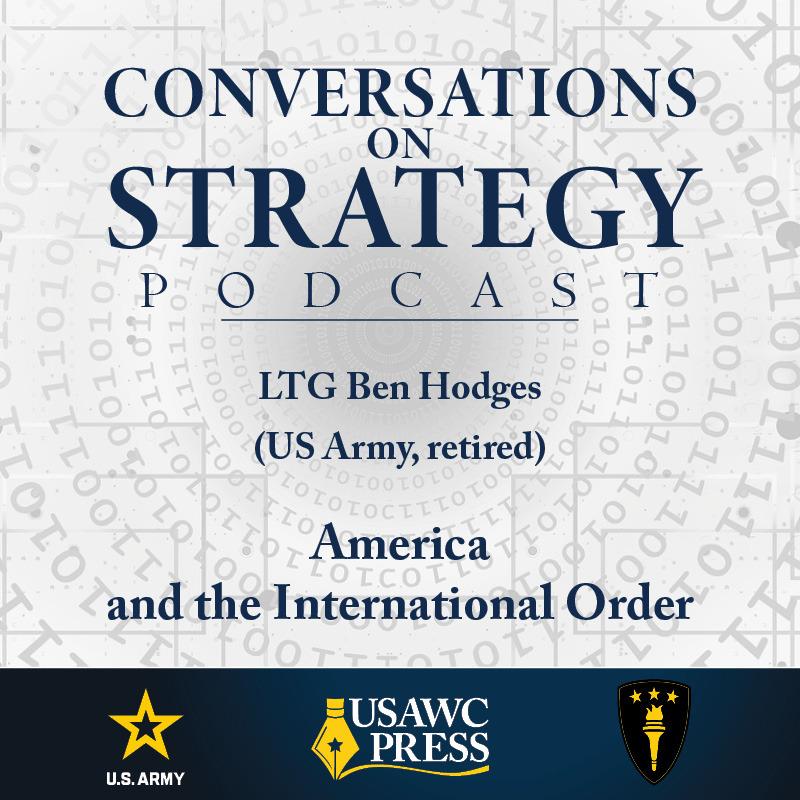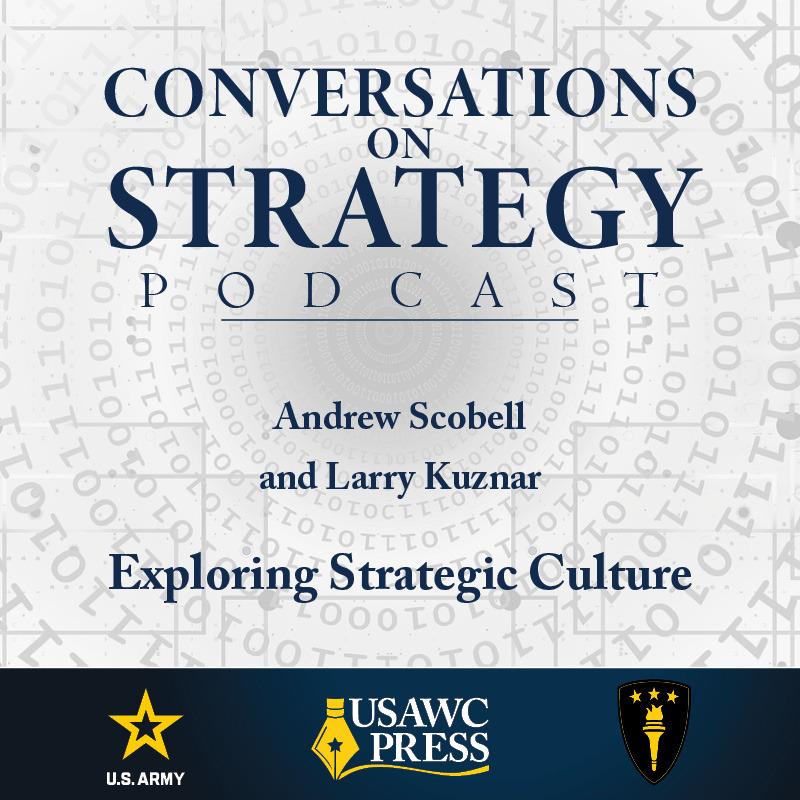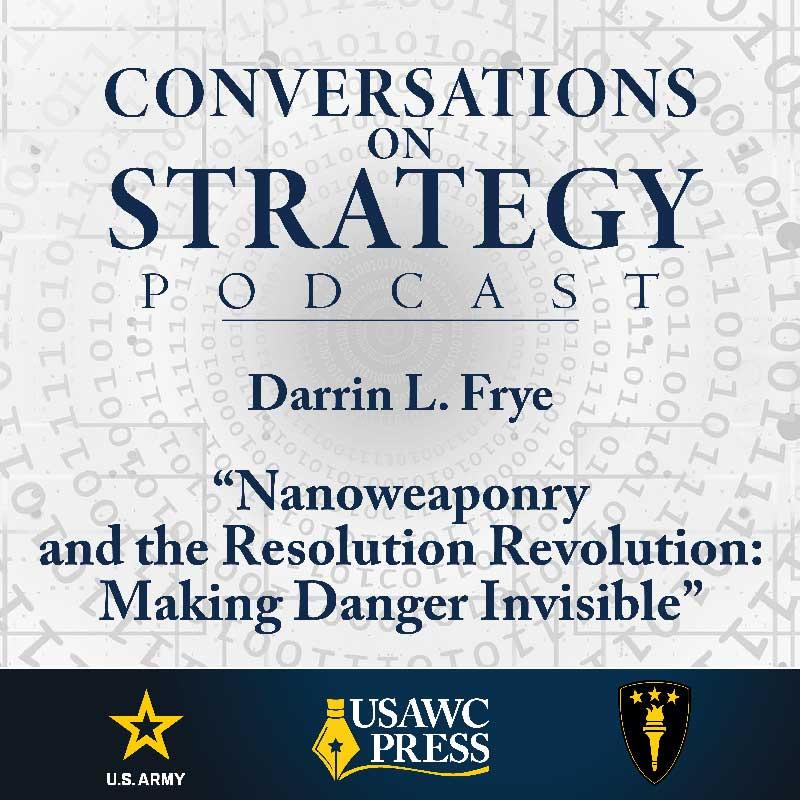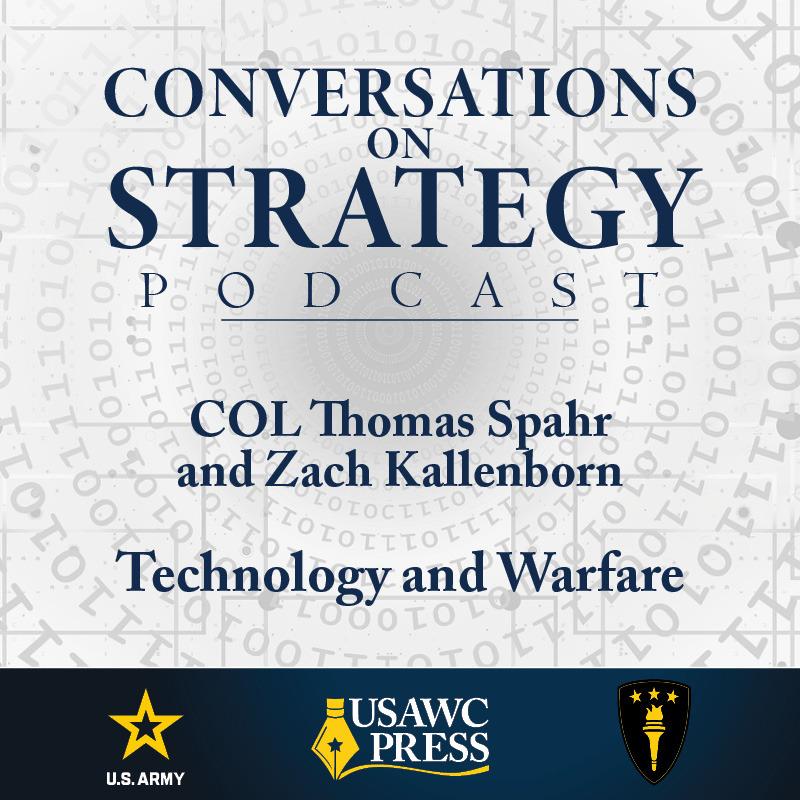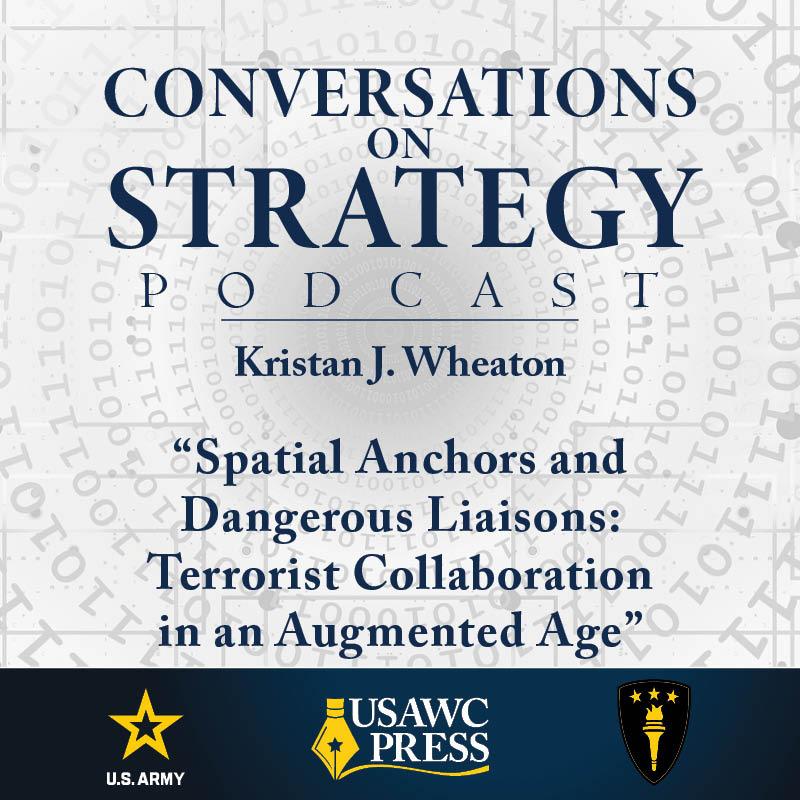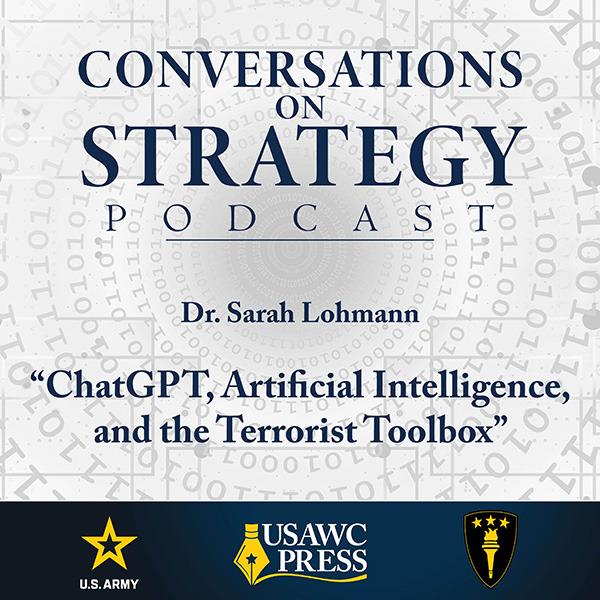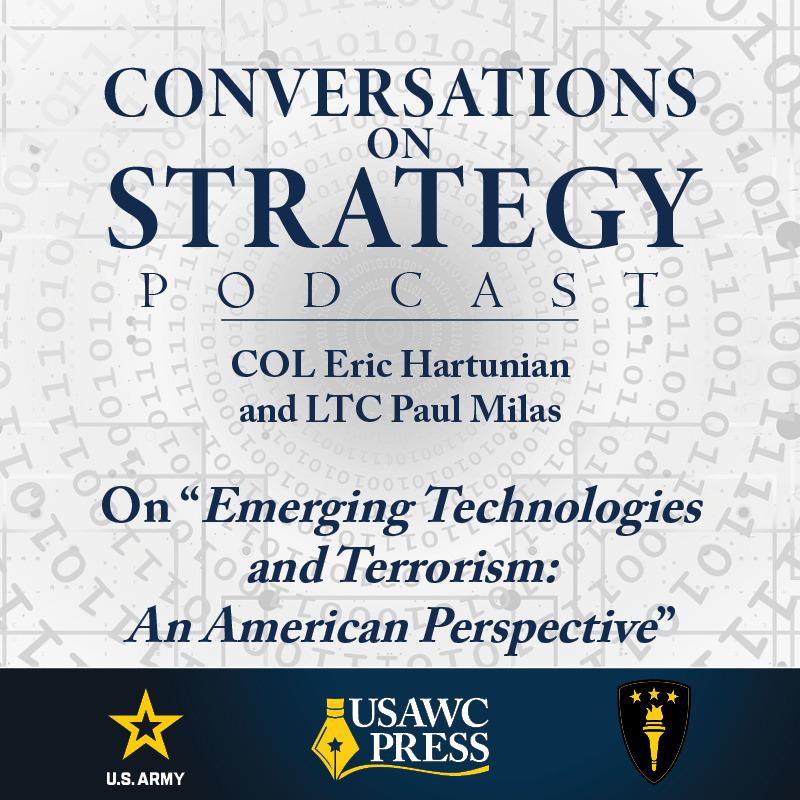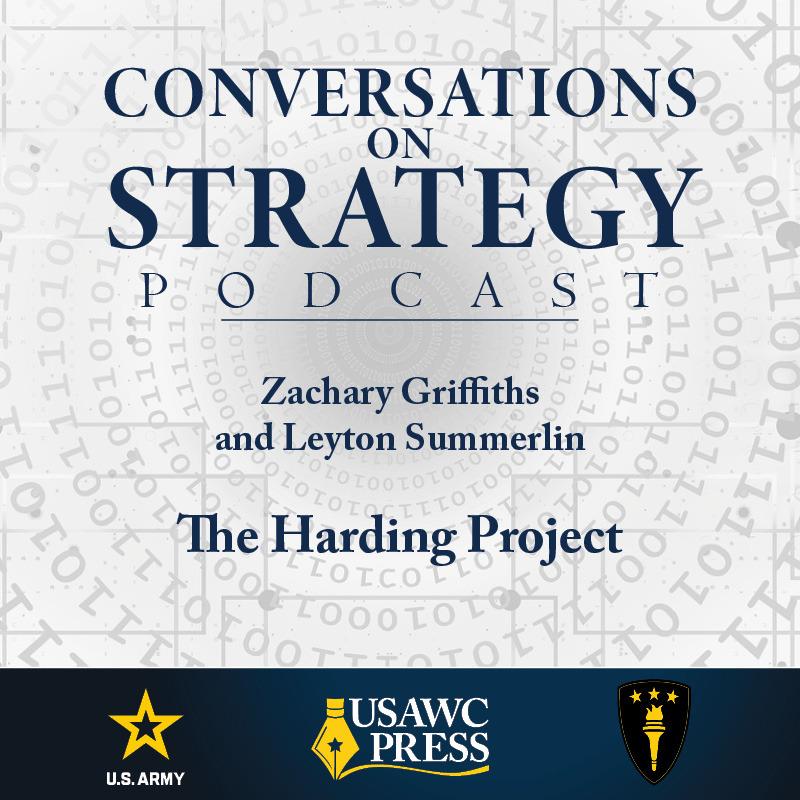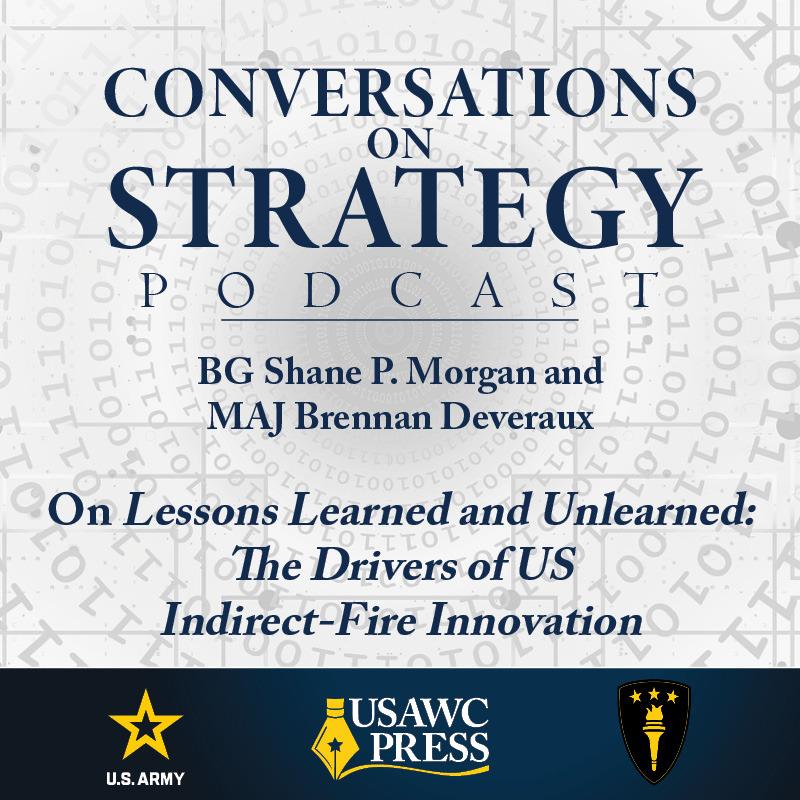Discover Conversations on Strategy Podcast
Conversations on Strategy Podcast

Conversations on Strategy Podcast
Author: U.S. Army War College Public Affairs
Subscribed: 10Played: 39Subscribe
Share
© Copyright 2025 Conversations on Strategy Podcast
Description
Conversations on Strategy features quick analyses of timely strategic issues. Topics are geared toward senior military officials, government leaders, academicians, strategists, historians, and thought leaders interested in foreign policy, strategy, history, counterinsurgency, and more. Guests include Press authors and subject matter experts from the US Army War College and other PME and academic institutions who discuss hot topics like the Russia-Ukraine War, China, Taiwan, artificial intelligence, manned-unmanned teaming, infrastructure, terrorism, urban warfare, the Middle East, and more.
Questions or feedback? E-mail usarmy.carlisle.awc.mbx.parameters@army.mil
Questions or feedback? E-mail usarmy.carlisle.awc.mbx.parameters@army.mil
61 Episodes
Reverse
In this episode, Antulio J. Echevarria II discusses how NATO might better leverage risk to strengthen the alliance’s extended deterrence. Can NATO increase the risks and costs of war for an adversary without unduly raising the alliance’s own? Can the alliance strengthen the credibility of NATO’s extended deterrence through a proxy strategy of “waging war without going to war”? Keywords: risk-benefit models, cost-benefit models, military risk, political risk, Russian deterrence, risk aversion, self-deterrence, deterrence by denial, deterrence by punishment, proxy warfareStephanie Crider (Host)You are listening to Conversations on Strategy. The views and opinions expressed in this podcast are those of the guests and are not necessarily those of the Department of the Army, the US Army War College, or any other agency of the US government.I’m in the studio with Professor Antulio J. Echevarria II.Echevarria is currently a professor of strategy at the US Army War College and the editor in chief of the US Army War College Press, which includes Parameters. He’s held the General Douglas MacArthur Chair of Research and the Elihu Root Chair of Military Studies and is the author of six books on military strategy.He’s the author of Weaponizing Risk: Calibrating Western Deterrence, which was published by the US Army War College Press in July 2025.Welcome to Conversations on Strategy, Dr. Echevarria.Antulio J. Echevarria IIThank you. I’m pleased to be here.HostI’d like to start with understanding risk in strategic thinking. You introduce the idea of weaponizing risk. Please explain how risk-benefit models differ from traditional cost-benefit approaches.EchevarriaTraditionally, cost-benefit models are designed to persuade an adversary, an aggressor, [or] potential aggressor, that the costs of a particular action are going to outweigh its benefits. The problem has always been that we don’t necessarily know where the cost ceiling is for that adversary, so we don’t know how far we have to go in order to dissuade them from doing the action we don’t want them to take. And the other problem is we don’t really know how much they value that particular object or piece of territory that they might be after.We do the best we can with our intelligence analysis, and we develop a model that we hope will work. Where, opposed to risk-based deterrence models, risk-benefit models actually allow us to go right at the heart of what an aggressor regime values most, which is its political survival. So, we step back, look at the calculations and, instead of trying to drive up costs in terms of economics or military materiel destroyed and personnel loss, we look at what about this particular situation will pose a direct threat to the regime and its political survival.Although every regime has a cost ceiling—Putin, for instance, certainly does, but it may be a lot higher [than we expected], as we have seen in recent times—the Russian cost ceiling is much higher than it is for the West and certainly for Ukraine. So, we need a method to get around just a basic cost-benefit approach. So, the risk-benefit approach does help us do that because we have to answer our own question, which is: Are the costs we are about to impose, or threatening to impose, really going to get at the heart of what the regime actually cares about? If so, how long will it take?HostI’m glad you brought up Putin and Russia. You suggest NATO’s support for Ukraine amounts to a form of proxy warfare. How might NATO better leverage this proxy relationship to strengthen its deterrence of Russia?EchevarriaNATO’s best bet is a strategy of deterrence by denial. Deterrence by punishment really kind of reinforces the entire dynamic, or cycle, of a cost-benefit model. We already discussed its shortcomings. But deterrence by denial helps us the most because if the regime can’t take that thing that [it] is going after, it can’t conquer Ukraine, for instance, then it puts its political survival at risk because strategic failure is a threat to any political regime, but especially autocratic [ones].We have a lot of literature on this. So, strategy of denial by strengthening—the language of the day is to “porcupine it up.” So, “porcupining up” Ukraine or Taiwan or another threatened territory—is one way to, I think, increase extended deterrence.Now, what we want to do is not just impose costs on an invader or an aggressor but actually defeat their attempts to take over that particular country or its administration, its government. It’s all about imposing defeat, and NATO can do that by mobilizing its political might, its industrial might, [and] its military might in terms of hardware. It won’t really have to put troops on the ground, so that’s a benefit. But it can, in a way, fight a war without going to war, so to speak—so, wage war without going to war. And that’s the best of all scenarios. So that’s what I’m arguing.NATO, in a way, backed into a proxy war situation with this conflict. But, imagine if it had been better prepared, if the infrastructure had been in place already—the material infrastructure as well as human infrastructure—so you could maintain a flow of materiel, you could move right into rapid training scenarios, provide other support, intelligence support, for instance, right at the get go. Had we been able to do that, for instance, we would have strengthened Ukraine’s ability to defend itself and we would have started weakening Russia earlier on and we would have maybe started to push it towards its cost ceiling faster.HostRussia invading Ukraine was not a surprise, right? NATO and Europe could have been better prepared in all the ways you just mentioned.EchevarriaRight. That’s true. It was not a surprise, but it was still a shock in a way because the preparations we had put in place since 2014 were more a line of hybrid warfare. If you look at what the money was invested in, the US and the Europeans gave support to Ukrainians to bring their defense spending on par with Poland’s and Norway’s [and] others who took the Russian threat seriously. But, a lot of the literature, a lot of the analysts, were talking about another wave of hybrid sorts of attacks.What came as a surprise was this full-scale invasion, basically what we would call today a large-scale combat operation, that we were not really prepared for. And, had we taken deliberate steps early on, I think we would have seen, perhaps, a different outcome. Now, we might not have still deterred Putin because leaders do make poor choices at times, and he might have wanted Ukraine so badly that he had to attack anyway. But, we would have had Ukraine in a better position to defend itself, [which is] the bottom line. And, again, we would have maybe moved Russia towards its cost ceilings faster. I mean, you could do everything right in the deterrence world and still fail to deter a determined aggressor, but everyone knows this, it’s pretty much common knowledge across the field.HostRecommendations. What concrete steps could NATO take now to strengthen its credibility with regard to extended deterrence?EchevarriaSome immediate steps: I think it could revise its strategic concept, for instance, as well as its political guidance for defense planning. If we include more strategy-of-denial language, and we start talking about the kinds of assistance we are going to be prepared to give to Ukraine throughout a run-up to a conflict again, and throughout the conflict, that sends a message to Moscow that it’s not going to be a cakewalk, that maybe they would want to think twice about this before launching into it.The other thing we can do—and should do—is to revise the operational documents that NATO has, its foundational ones, for example, the Allied Joint Doctrine for the Conduct of Operations and the Allied Joint Doctrine for Land Operations. Both of those assume that NATO is the one that’s going to be doing the fighting. That is not necessarily the case. We may be aiding someone else who’s doing the basic fighting. So, we should begin to talk about how we would do that more efficiently moving forward. We should work those kinds of scenarios into our general defense plans, we should war-game out in advance different alternatives, and so on, [including] courses of action. We should do all of those things. We can do those concretely right now. Those are my recommendations for immediate steps.HostThank you for making time to speak with me today, Dr. Echevarria. It’s always a pleasure when I get to chat with you.EchevarriaMy pleasure.HostListeners, you can read the monograph at press.armywarcollege.edu/monographs/981. For more Army War College podcasts, check out Decisive Point, SSI Live, CLSC Dialogues, and A Better Peace.
In this episode of Conversations on Strategy, Major Brennan Deveraux interviews select authors of The Weaponization of Artificial Intelligence: The Next Stage of Terrorism and Warfare, a book written in partnership with NATO Centre of Excellence – Defence Against Terrorism (COE-DAT). The authors discuss their respective chapters, which include topics such as how terrorists use large language models, the use of artificial intelligence (AI) as a weapon, and the future of AI use in terrorism and counterterrorism. Keywords: AI, artificial intelligence, terrorism, counterterrorism, large language models (LLM), technology, security, privacy, ethicsBrennan Deveraux (Host)You are listening to Conversations on Strategy. The views and opinions expressed in this podcast are those of the guests and are not necessarily those of the Department of the Army, the US Army War College, or any other agency of the US government.I’m your host, Major Brennan Deveraux. Today we’ll be talking about the newly released book, The Weaponization of Artificial Intelligence: The Next Stage of Terrorism and Warfare. I’m joined today by some of the book’s authors, and we’ll be exploring some of the findings and broader implications of the analysis. I have five guests with me.The first is Dr. Tony Pfaff, the director of the Strategic Studies Institute. He was the project director and contributing author to the book. The second is Dr. Sarah Lohman, a University of Washington Information School faculty member and Army Cyber Institute visiting researcher. Her chapter of the book is entitled “National Security Impacts of Artificial Intelligence and Large Language Models.” The third is Dr. Gábor Nyáry. He’s a research professor at the National Public Service University in Hungary. His chapter was entitled “The Coming of the Techno-Terrorist Enterprise: Artificial Intelligence and the Tactical, Organizational, and Conceptual Transformation [of] the World of Violent Non-State Actors.” The fourth is Dr. Thomas Spahr, the [Francis W.] De Serio Chair of Theater and Strategic [Strategic and Theater] Intelligence at the US Army War College. His chapter is entitled “Raven Sentry: Employing AI for Indications and Warnings in Afghanistan.” Finally, Colonel Christopher Lowrance [is] an associate professor in the Electrical Engineering and Computer Science Department at the US Military Academy. He coauthored a chapter with Dr. Pfaff entitled “Using Artificial Intelligence to Disrupt Terrorist Operations.”For my first question, Dr. Pfaff, I’d like to look to you. If you could tell us about the project as a whole, talk a little bit about the relationship between the Strategic Studies Institute and NATO that led to this project and just a little bit about bringing the team together.Tony PfaffThanks for that question. This project was a yearlong collaboration between us here at the Strategic Studies Institute and the NATO Centre of Excellence-Defence Against Terrorism (COE-DAT). The intent was to explore how emerging artificial intelligence technologies are capable of—or have the potential to—transform both terrorist operations and, by extension, counterterrorism strategies. The COE-DAT initiated the project with the aim of not simply [performing] an academic exercise but producing actual insights for NATO, partner nations, [and] anyone involved in the counterterrorist enterprise.As the lead editor and project manager, we built [an] extremely competent and interesting multinational team of experts, who came from a variety of backgrounds, bringing together academic researchers, military practitioners, legal scholars, and so on. And, everyone brought in their own unique lens, whether it was technology, law, strategy, or on-the-ground experience, which, I think, makes this volume somewhat unique and, when taken as a whole, [it] provides a fairly comprehensive picture particularly useful to practitioners and policymakers on how terrorism might evolve, given these technologies, and what we can do about it.Moreover, while I wouldn’t consider the book technical in nature exactly, we did try to ensure there’s enough information about how the technology works to demystify it so that practitioners could more easily assimilate its findings into what they were doing. [This] joint effort was not only about researching on the weaponization of AI by terrorists, I think it also—kind of going to the last part of your question on bringing the team together—has been [part of] a series of projects we’ve worked [on] with the COE-DAT that has strengthened our institutional relationships between us and our NATO partners and, hopefully, is fostering a deeper dialogue between the community of scholars and practitioners that we hope to connect through this volume.HostThanks for the big overview, sir. If we could transition now to the chapters, Dr. Lohman, I’ll look to you first.Your chapter was on the impact of artificial intelligence on large language models (LLM), and you talked about some vulnerabilities and the potential for exploitation. Can you talk to us a little bit about the threat, what it could mean to the Defense Department, and how large language models could work [and] maybe even provide an example without getting overly technical?Sarah LohmannSure, thanks so much for having me.What we know, Brennan, is that large language models and their platforms are being used by terrorists for hate speech and recruitment, impersonation, and also creating malicious code for cybercrime. And I just want to back up here a second and define that LLMs are actually a subset of generative AI, which most of us are familiar with due to ChatGPT. It basically uses that natural language processing to understand and generate human-like language outputs.But, when you look at the most recent studies and a lot of what’s going on in the world in terms of how terrorists are using those large language models, we saw evidence in interviews with tech and software companies based on hundreds and hundreds of pages gathered up by the House of Lords that showed that these kinds of threats, including inciting terror, are going to continue to increase through 2027.But actually, what keeps us up the most at night is how those models can be used to attack critical infrastructure or military and civilian logistics in order to facilitate their own terrorist operations. The study actually showed that catastrophic risk, which could cause, for example, 1,000 fatalities or damages close to $13 billion, are less likely till 2027, but can’t be ruled out.One example of an LLM failure linked to services, which could be catastrophic, is, for example, water purification or electricity turning on that could trigger an outage across critical national infrastructure if the LLMs were not properly segmented from their operating systems, or if those systems were not cyber secured. An especially sensitive issue for the military could be if LLMs linked to a port or a train system, aviation, or manifest, for example, were hacked. So, LLMs are incorporated into those infrastructures specifically to update those systems in real time. That’s why we have them there. They make our lives easier. They help us reroute planes if there’s bad weather or they help us update the weight of a train load. They help us sync which cargo has been shipped from a port or what materials are needing to be transported from one base to another.I just want to give you one specific example. Let’s just take the example of a military manifest. One of the top 10 vulnerabilities for LLM applications is called prompt injection. Basically, that essentially manipulates the system and responds to the prompts with malicious inputs that overwrite those system prompts.I want to give you an example of how one of my students, Chris Beckman, was able to do this LLM demonstration to illustrate prompt and reverse prompt injection to show the dangers. Now, you don’t have to be a specialist to understand this. You have to imagine a military manifest could be directing a truck to deliver petroleum to a specific base, but a hacker could change the contents of the truck to explosives by responding to the LLM prompt that they are the admin. Now, this is obviously not something that any of us could do, but he was able to demonstrate it by going in and training those prompts differently. They can then change the destination of the truck with reverse prompt injection by running code remotely and accessing a plug-in to that with the result being that the truck is now delivering explosives to, for example, terrorists in the nation’s capital.Those are difficult attacks to prevent, which is why it’s always critical that LLMs be segmented from their critical infrastructure operating systems and only be given access by authorized users.HostThat’s great and rather terrifying.LohmannYes, indeed.HostSo, your lens is very much on terrorism, and [how] we think about defending ourselves and somehow addressing these threats. Can you talk a little bit about the potential implications of this beyond terrorism as we look at great-power competition, even actual conflict with a nation that’s much more capable than, say, a terrorist or non-state actor at manipulating these LLMs? And, is this potentially something we should be looking at not just defensively but as we look at warfare extending beyond our conventional domains? As we talk about cyber soldiers and artificial intelligence, is this something that you see as being an aspect of a future war?LohmannAbsolutely, and it already is. We already know that Microsoft and OpenAI, the inventor of ChatGPT, have announced that countries like Iran and North Korea, Russia, and also China are using generative AI for offensive cyber operations. Specifically, those countries used LLMs for early stage attacks to compromise networks and to conduct influence operations. But, in the contested or competitive environment that you’re talking about, Brennan, where you have
In this episode of Conversations on Strategy, Mr. Patrick N. Kelleher and Brigadier General Ronnie D. Anderson Jr. discuss the importance of logistics and readiness. They recommend senior leaders shift their perspective on these topics to keep up with changes in the strategic environment and evolutions in technology. Kelleher and Anderson also discuss the role of resilience for modern logistics and new innovations and their effects on the force. Keywords: logistics, readiness, strategic environment, senior leaders, resilience, modernization, commercial partners, technology, AI, alliances, sustainmentStephanie Crider (Host)You are listening to Conversations on Strategy. The views and opinions expressed in this podcast are those of the guests and are not necessarily those of the Department of the Army, the US Army War College, or any other agency of the US government.I’m talking with Mr. Patrick N. Kelleher and Brigadier General Ronnie D. Anderson Jr. today.Kelleher is the Deputy Assistant Secretary of Defense for Materiel Readiness, where he serves as the principal adviser to the Assistant Secretary of Defense Sustainment.Among other notable achievements, he served 24 years on active duty in the Marine Corps.Anderson is the director of the Contested Logistics Cross-Functional Team at US Army Futures Command. He previously commanded Joint Munitions Command.Welcome to the show, gentlemen.Brigadier General Ronnie D. Anderson Jr.Good morning. Thanks for having us.Mr. Patrick N. KelleherGood morning. Thank you.HostLet’s talk about logistics and readiness. Mr. Kelleher, you opened a recent LinkedIn post with the line “logistics is strategy.” Please explain what that means in the context of the current strategic environment.KelleherThe current strategic environment is obviously, you know, for those that follow it, very different than an environment in which we have operated for the last 25 or 30 years and more similar to the environment of World War II. And so, I think what that necessitates is the imperative to think about how we approach our strategy a little differently.In the past, I think we had the latitude to design a strategy and then determine if it was logistically supportable, or simply turn to the logisticians and say, “This is what we’re going to do. Support it.”I think now our strategy must be predicated on achievable logistics at its foundation. And so, where in the past, maybe, logisticians weren’t as involved as much as we probably should have been in developing a strategy. I think now, logistics should drive the strategy, and we should not even consider any strategic objectives or a campaign plan without first determining logistics feasibility, given the challenges in the environment—which, as I said, [are] very different [from] where many of us have fought in counterinsurgency operations for the last 25 or 30 years. So, at the macro level, that’s how I would describe it.HostGeneral Anderson, how do you see that concept playing out on the ground or in Joint planning environments?AndersonThanks.First, I would say that I believe Mr. Kelleher’s premise, his post, and what he just laid out is absolutely correct, and it’s supported by what we’re seeing in our global military history happening right now. Many nations can project power. We’ve seen Russia in Syria. We see North Korea in Ukraine. China is starting to reach beyond its first island chain. But the United States is the only country on the planet that can project power anywhere on the globe in 12 to 72 hours and sustain that force indefinitely. That is our strategic advantage. But it can also be a strategic challenge, as Mr. Kelleher said.So, every strategy has to be rooted in supportability. I also believe that that’s why contested logistics today is so important. Our adversaries know that our ability to project and sustain power on the globe is our strategic advantage, and they are rehearsing in the Pacific and across Europe to challenge our strategic advantage.HostMr. Kelleher, you made a reference to World War II and needing to update how we view logistics. Are there any specific misconceptions that you think senior leaders still hold about the role of logistics?KelleherI wouldn’t characterize them necessarily as misunderstandings or misperceptions. Many senior leaders in the Department of Defense, myself included, have served over, you know, the last two or three decades in an environment where we have not been contested, where we have been able to dominate in three domains. Now, we find ourselves challenged in five or six domains, depending on how you want to list out the domains.And I think that that is a paradigm that, while people nominally acknowledge, you know, in the words that they say, I don’t think has necessarily been internalized because too many senior leaders have been conditioned, frankly, by logisticians, who have never failed, to have an expectation that logistics will not fail. But, because the environment has changed so dramatically, there may be a misperception [about] the fundamental logistics capabilities that we have and the degree to which we will be able to leverage them and the degree to which we have the capacity and capabilities writ large—the depth and resilience—that will be necessary to support the next fight, which are well beyond the depth and resilience that we needed for the last 20 or 30 years, because the environment is so profoundly different.And I think that’s sort of the cognitive dissonance, if you will, that might exist. Although people talk about the importance of logistics, I’m not sure how much that has been truly internalized, as manifested by the investments that are being made into logistics to compensate for the logistics debt that we have incurred over the last 20 or 30 years.I mean, I think the good thing is, as you look at where the spending curves are going over the next couple of years, the trend lines are good. They’re getting better. But it’s still, I would argue, not where we need to be to compensate for the deficiencies nor the shortfalls or the compromises, [and] the tradeoffs we have made with logistics capabilities over the last 20 or 30 years.HostCan logistics posture alone shape adversary decision making even before conflict begins?AndersonI got the pleasure of serving at the CENTCOM (US Central Command) headquarters when [General Kenneth F. McKenzie Jr.] was the commander there. It was entirely obvious how behaviors in the region changed based on posture. One of the things that I think about now, especially in the context of the Indo-Pacific, is what would happen if we either covertly or overtly deployed THAAD (Terminal High Altitude Area Defense), PrSM (Precision Strike Missile), long-range hypersonics and then just announced to the world, “Hey, look, we have this capability, and we’ve postured it forward?” Even for an exercise, right? And then we can make a strategic decision at that point to see whether it stays in position or if we bring it home and we just make a show of our ability to deploy something, get it there, demonstrate its potential, and then bring it home. It would be very important, and it would be a great lesson learned for us to observe the insights from our competitors’ behaviors when we do that.It was completely obvious every time a carrier strike group arrived in the Persian Gulf how our adversaries changed their behaviors. When we demonstrate the ability to respond to a hurricane or a flood or an earthquake in the Middle East, our ability to sustain those things logistically and have boots on the ground in a very short order, it changed the behavior of those people competing and wanting to counter our influence in the region. And that happens in every part of the globe every time we demonstrate that capability.HostTurning to readiness, Mr. Kelleher, you’ve said logistics underwrites both readiness and resilience. How are we modernizing sustainment systems to keep pace with current threats?KelleherReadiness equates to our ability to fight and win. Posture is a manifestation of our ability not just to deliver kinetic effects but to endure and continue to deliver kinetic effects. And so, posture is a manifestation of what I’ve written about—the logistics deterrent effect that General Anderson was just referencing. When our adversaries understand that we have the ability to endure, on top of our ability to deliver kinetic effects—to punch them in the face, and then to continue to punch them in the face—over time, as manifested by how we have our capabilities represented by posture throughout the world, I think those are sort of the foundational capabilities as [to] how readiness contributes.Now, what I would say in terms of systems, maybe we could talk about this from a technological perspective and the application of artificial intelligence to help us make better decisions, the application of artificial intelligence to enable us to be more predictive. But I would also say that we’re rethinking the ecosystem of sustainment in a broader context to equate from a regional perspective—and so, that regional posture, coupled with a more deliberate systemic approach to regional sustainment that incorporates partners and allies; their military and commercial capability; [and] our commercial capabilities, coupled with our posture, coupled with logistics support arrangements that we already have in place with other countries, coupled with things like the state partnership program that the National Guard runs—and so, weaving that together in a logistics ecosystem that builds on posture to enable us to have a system, if you will, to support operations, to support operations from a forward perspective, as opposed to having to bring things back to CONUS [the continental United States].AndersonAnd can I pile on to that with some of the experience that Mr. Kelleher would have had while he was still in uniform? Most of us in uniform can relate to just being able to sustain Afg
In this episode, Major Brennan Deveraux interviews Dr. C. Anthony Pfaff, Colonel Michael Shekleton, and Colonel Clayton T. Manning on the recently published Strategic Questions Research List (SQRL). They discuss the contents of the SQRL, how it differs from previous years’ compendiums to the Annual Estimate of the Strategic Security Environment, and how it can be used by students during their research.Keywords: Strategic Questions Research List (SQRL), research, academics, research questions, sponsors, Strategic Research RequirementMajor Brennan DeverauxHello, you are listening to Conversations on Strategy. The views and opinions expressed in this podcast are those of the guests and are not necessarily those of the Department of the Army, [the] US Army War College, or any other agency of the US government.My name is Major Brennan Deveraux. I work at the Strategic Studies Institute (SSI). I will be the guest host for this podcast on our Strategic Questions Research List (SQRL) and all associated podcasts for the Strategic Estimate.I’m joined today [by] three guests. The first is Dr. [C. Anthony] Pfaff, the director of the Strategic Studies Institute. The second is Colonel [Michael] Mike Shekleton—my boss—the director of the Strategic Research and Analysis Department (SRAD) here at SSI. And then, Colonel Clay Manning, a professor at the US Army War College’s School of Strategic Landpower (SSL), as well as the director of the Strategic Research Requirement (SRR).Dr. Pfaff, I’m going to start with you today. The Strategic Questions Research List, also known around the War College as the squirrel (SQRL)—fun name—can you tell me a little bit about what it is, why it’s important, and why we’re having this conversation today?Dr. C. Anthony PfaffIt’s a great question. And I guess [I will share] a little bit about the history of the name: In the before times, we often relied on something called the Key Strategic Issues List, also known as the KSIL, that was both loved and hated by various entities, both here at the War College and abroad. Part of the problem with the KSIL was that it wasn’t well aligned in any given year with the requirements of the service and of DoD (Department of Defense) in general. So, it had gotten abandoned, and we had started using just the Strategic Estimate, but then we kind of discovered that we still weren’t properly aligned with the field. And so, the SQRL became our effort to do that, as we would reach out to major commands, agencies, and others who we would consider our stakeholders, and ask them what their resource priorities are.We came up with the name because Research Questions List is RQL (Urkel), and that was right out. Strategic Research Questions List was SRQL (circle), and we certainly don’t want any more of those around here. Then, it was Strategic Questions Research List, which is a little awkward to say out loud, but it does form the acronym SQRL, and chasing squirrels is always fun.That’s how we got the name. And, it’s our effort to be as aligned as possible with the national security challenges that we’re facing in ways that are interactive in using it. Unlike the KSIL, [in] which you sort of drop the [questions] on the researchers, who are the students, this is [an] interactive process where we help shape the questions so that they’re easier to use and then have a mechanism and a venue for providing the feedback from the research back to the field. That’s what we’re trying to do here.Back over to you.DeverauxI like the name. I think it’s catchy. It’s easy to remember. Although, as you recall, I was very nervous the first time we said it in a big meeting and made sure I kept saying Strategic Questions Research List.Quick follow up for you, sir, on the SQRL. Who’s it for? Is this just a War College product, a PME (professional military education) product? Who are we getting this out to? And are the sponsors, those customers, are they looking for anything specific? Are they looking for giant theses? Strategic long papers? Does that vary by command?PfaffWe’re trying to be as flexible as possible. So, there’s room for all the above that you just talked about. Now, in some cases, [with] these questions, there’s not a lot of research behind them, so there’s the opportunity to do some groundbreaking work. That’s going to take longer. That’s also part of the interactive process is that we help build expectations, both for the sponsor and for whoever takes on the question. There may be some things that take a while that require the full year or so to get done. However, what we got this year was a clear demand signal from the field for shorter turnaround things and responses. And so, we do have some formats—that, for those of you who take on these questions, we’ll provide you—that allow you at least to get an initial response out back to the sponsor in order to, kind of, fill that need, particularly where there is already a lot of research already done.Now as far as who it’s for, pretty much anybody who is in the community that does research for the DoD, these are questions that they could take up, and we hope to get this promulgated out to a lot of those agencies. However, a major focus is getting [the questions] out to the student community so that they get to do two things. One is that just reading the list, you get a feel for what the DoD cares about right now, which may not only inform the [kinds] of projects you take on while you’re here but should [also] inform how you interact with your other courses.So, a short response here to wrap it up [is], basically, it’s for anybody who can use it. If you do use it, we would just ask that we are also included in how you provide any feedback to one of the sponsors.DeverauxGreat, thanks. I’ll transition over to Colonel Shekleton. We had questions last year—in fact, we had a bunch of questions last year. We didn’t have the catchy name. That’s not all that’s changed. Can you talk to us about the shift in how this product has grown from last year’s version to this year’s version?Colonel Michael ShekletonAbsolutely, Brennan, Thanks for that question.Last year we had 101 questions. This year we have 100 questions. So, at the surface level, it may look very similar. Where the big change is, is [that] last year we had 11 organizations that provided questions; this year we had 43. And so, there’s a couple of ramifications from that. First off, with having that many organizations but the same [number] of questions, it means that what we’ve got from these 43 different organizations are their top two or three or so priority questions. And so, in other words, the command was able to put their thumbprint on, “Hey, we would love if the War College and—more broadly, the research community—could look at this challenge, look at this issue.” The participation and the focus [is a big difference] that really marks this year’s SQRL [with] the KISL of years past.The range of organizations that provided us questions include the Headquarters, Department of the Army (HQDA), and so, most of the principal officials at HQDA provided questions. We also got [questions] from the four-star Army commands, the Army service component commands, the combatant commands, as well as a handful of other Joint and Army commands. We think we have a really good range of organizations that provided questions.What this now affords to the students and the faculty is that most of them should be able to see themselves in the SQRL, whether it’s [that] they’ve got relevant experience from previous assignments that allow them a unique window or insight into trying to address the question and provide recommendations, or, it may align with a diverse range of professional interests. We think we have a pretty good starting point to help facilitate research over the next year.DeverauxAs we’re doing the research, whether that’s a faculty member, a student, or to the earlier point, just a[n] interested Defense Department researcher, someone who just wants to tackle one of these problems, is there any sort of feedback loop? How are we getting research back to those customers? We talked about this being an iterative process when the questions are coming in. Are we iterating continually as we’re working through this? [Are] there opportunities for that dialogue?ShekletonBrennan, absolutely.Prospective researchers can reach out to either myself or to you. For those who are listening to this, if you look at the back of the Strategic Estimate, on the back cover it’s got a list of the entire team that contributed to the Estimate, whether as an author or [someone] helping to put it together, and you’ll find [Major Deveraux’s] and my name, Colonel Shekleton, on the back. And so, for those of you on the DoD network, you’re able to reach out directly using the global address list.For those who may be at an academic institution or somewhere else where you don’t have access, there’s an ability on the Strategic Studies Institute website to write to the Institute. And, that e-mail traffic would be funneled to us, and then we can link you up with the command and, specifically, the point of contact (POC) for the command’s question.We collected these questions over the past several months. For example, when students start taking these questions up in earnest, later in the year, the strategic context may have shifted a little bit. And so, the question that an organization asked in the springtime may be slightly different in the fall. And so, by having that conversation with the command, it allows the command to refine—“Hey, here’s what we’re looking for, and if you could shift a little bit to this”—that will provide maximum value to the command and for the student, as well as for faculty members that are able to link up with these POCs at the commands. It allows you to understand the context for why the command’s asking the question. They may be able to provide some additional details. And with that, the researcher
Commander of the Canadian Army Lieutenant General Michael C. Wright discusses the Canadian Army, modernization, Ukraine, technology, and more. Listen in for insights about the Canadian Army, its mission, its future, and how America’s neighbor to the north partners with the United States. Keywords: Canada, Arctic, Canadian Army, technology, modernization Stephanie Crider (Host)You are listening to Conversations on Strategy. The views and opinions expressed in this podcast are those of the guests and are not necessarily those of the Department of the Army, the US Army War College, or any other agency of the US government.Lieutenant General Michael C. Wright, commander of the Canadian Army, is joining me remotely today. Wright enrolled in the Canadian Armed Forces in 1990 as an infantry officer. He has commanded from platoon to brigade and Joint task force levels. He served in Bosnia, Afghanistan, and the Middle East, as well as in Canada. On promotion to Lieutenant General in July 2024, he was appointed as the commander of the Canadian Army.Welcome to Conversations on Strategy, sir. Thank you for joining me.Lieutenant General Michael C. WrightStephanie, thanks very much for the invitation. [I am] really looking forward to this.HostI'd like to open our discussion with land warfare and modernization. Looking at the last three years of fighting in Ukraine, what are your most important takeaways regarding the evolution of land warfare, and how is the Canadian Army modernizing to meet this moment?WrightThanks, Stephanie.The Canadian Army, like all of our close allies, are paying very close attention to what’s happening on the battlefield in Ukraine. I think I’ll start with three key takeaways and then how it’s shaping what the Canadian Army is doing.The first one is that it has proven that Landpower absolutely matters. Landpower in terms of the conventional large-scale combat operations capability absolutely matters, which is really driving the modernization effort that we’re doing within the Canadian Army. Not only for the capabilities that we’re trying to bring in, but also for the wholesome review of our force structure that we’ve engaged in.The second one—and this is one that I actually spend a lot of time thinking about and, frankly, worrying about—is how rapidly technology is evolving on the battlefield. Just looking at drones, for example, the multiple iterations of drones, how they are used—how they’re use for reconnaissance, how they’re used for strike—has changed so many times over the past three plus years, and knowing the challenges that we have in many of our militaries in keeping up with innovation and procuring the equipment that we need in the right time frame.The third key take away is following on from that rapidly evolving technology, we certainly see the importance of precision, but I always like to remind people that it is not a binary decision between precision or mass. We actually need precision and mass because—I’ll go back to the first part—Landpower matters. And in fact, I think one of the major reasons why we’re seeing this conflict, this war, go on over three years is because that decisive Landpower has not been—certainly in the past year to year and a half—has not been able to be applied at the level that’s required to see a decisive victory by either side.HostThese are big enough challenges in the present, and I know you’re working a lot on modernization and looking into the future. Can you talk a little bit about your vision for the Canadian Army?WrightMy vision of the Canadian Army is really building upon the great work that was done by my predecessors. Immediately before coming into command of the Canadian Army, the focus of my predecessor, Lieutenant General Joe Paul, was very understandably on making the transition from our primary force-generation mission, the multinational brigade in Latvia, setting the conditions to move from the battle group level up to the brigade level. What I’m trying to do is the great work that was done there to ensure that all those capabilities that are being put in place in our mission in Latvia are actually going to be able to be scaled across the Canadian Army.The vision that I’ve laid out is that we need to make sure that we are a credible, interoperable, digitally transformed, modern Army that's capable of offering the government of Canada with agile and scalable options for employment in competition, in crisis, or in conflict. The way that I’ve divided that up in terms of priorities are modernization, reconstitution, and readiness, and it’s a deliberate ordering of those priorities because we need to modernize, and we need to reconstitute our forces both in terms of people and equipment before we can augment our level as readiness.If you want, I can talk a little bit about the modernization effort that we’ve embarked upon.HostI’d love to hear a little bit about that, please.WrightAbsolutely. Certainly, part of our modernization effort is a wholesale modernization of the capabilities we have in the Canadian Army. We are actually going through the largest modernization since the turn of the century, and that modernization that we did at the turn of the century really set the conditions for the decade plus that we spent in the counterinsurgency fight in Afghanistan, and then, certainly, the operations we were involved with in the Middle East. We have 47 major capital projects, but we all know, and you don’t have to learn this at War College, you can’t go around saying, “I have 47 priorities.” So, the way I describe it are there are four plus one, which are incredibly important for the future of the army. Those four are long-range precision strike; this is a capability that Canada has never had. It’s a capability that will, first of all, be incredibly important as part of that NATO mission in Latvia. But, it’s also a capability that has a continental and Canadian Defense nexus to it.The second one is ground-based air defense [GBAD]. This is actually a capability that Canada had, but then we divested earlier this century, and certainly lessons learned from Ukraine show the incredible importance of ground-based air defense. Luckily, there we’re already seeing the fielding of some dismounted systems in Latvia, but we’re moving aggressively to bring both dismounted and mounted systems into Latvia, but then also to field them across the Canadian Army and again including GBAD, being a perfect example of where that has a role in the defense of Canada.The third one is modernization of our indirect fire. So, that’s everything from our mortars up to what is going to be the eventual replacement for our M777 [howitzer 155mm artillery]. I think it’s going to be a self-propelled howitzer. Certainly, as we look at whether it’s the US Army or our closest allies around NATO, they’re all going the self-propelled howitzer route. So, I think that’s where we’ll end up going.The fourth one is actually directly tied to our defense policy update that our government put out last April, Our North, Strong and Free, which really emphasize the importance of the continent, but then [it includes] Canada and the Arctic for our national defense. And so, that’s domestic and Arctic mobility and enhancement, which is basically having the vehicles that allow us to be mobile and survivable in the Arctic.Now, I said “plus one,” and that plus one is making sure—it’s one thing to get all of those capabilities in, but we need to make sure that we have the command, control, and communication systems to allow us to integrate them across the Canadian Army, across our Canadian Armed Forces, and probably most importantly with our allies, whether that’s in a NORAD [North American Aerospace Defense Command], a NATO, or another partnership perspective.HostI’m really glad that you brought up the Arctic. My next question is about America and Canada. We have shared interests in the Arctic, including security and economic development. Tell me a little bit more about the collaborative efforts between our two countries and maybe share your thoughts on them.WrightAbsolutely. And, it’s interesting because I was on a panel earlier today where I was side by side with the commander of the Royal Canadian Air Force. If he was here, he would talk to you about the importance of our binational relationship, really a unique binational relationship that we have with the United States through NORAD. Traditionally, from the Canadian Armed Forces perspective, we’ve looked more at the Air Force, and then, over the past decade, the Navy as well, because it’s not only that aerospace, but also maritime approaches [that we need in the Arctic]. But I think it’s important for me to be able to express to our government the role that the Canadian Army can play in continental defense.I spoke a little bit about some of the capabilities that we’re pursuing and how that will involve the Army more in terms of that homeland defense. It’s also for the Canadian Army right now, we represent the only permanent posture, or the only permanent presence, in the Canadian Arctic with our Rangers [a component of the Canadian Armed Forces Reserve]. Now, our Rangers are not like American [US Army ] Rangers or even [the Swedish Army Rangers]. I had the opportunity to visit Sweden last month and saw their Ranger regiment. What our Rangers are a force of 5,000 people who are located in over 200 isolated and coastal communities in the north and the Arctic. And, in fact, 1,800 of them are actually north of the Arctic Circle.What they do provide for us is presence [and] sovereignty. We’re ensuring that we are tying them closer into reporting so we’re able to plug into that domain awareness that we have in the Arctic. But, they’re also incredibly important for us, not only in terms of the relationships they have with the communities in the north and in the Arctic, but also as we send up members of both our regular force and reserve forces to train, we rel
TranscriptThis podcast was recorded on January 28, 2025, and updated on February 11, 2025.In this episode, Dr. R. Evan Ellis discusses the Panama Canal, including its history and significance to the United States, China’s involvement in the region, and Secretary of State Marco Rubio’s visit to Panama in February 2025.Keywords: Panama Canal, Secretary of State Marco Rubio, China, trade, President Jimmy CarterStephanie Crider (Host)You’re listening to Conversations on Strategy. The views and opinions expressed in this podcast are those of the guests and are not necessarily those of the Department of the Army, the US Army War College, or any other agency of the US government.I’m happy to be here today with Dr. Evan Ellis. Ellis is a professor of Latin American studies at the Strategic Studies Institute at the United States Army War College.First, I just want to welcome you back. I know that we’ve been talking for a while about recording another podcast. Thank you for making time to join me for another Conversations on Strategy.Dr. Evan EllisStephanie, it’s a pleasure to be part of the program today. Thanks for having me.HostSo, we’re talking about Panama today. I’d like to really dig in and get a better understanding of things here. What did the original agreement regarding the Panama Canal say?EllisWell, by “original agreement,” of course, we’re talking about the agreement on September 7th, 1977, in which President [Jimmy] Carter agreed with President [Martín ] Torrijos of Panama to, essentially, return the Panama Canal and, in turn, Panama agreed to, essentially, defend and maintain and operate the canal. So, there are really two components of this. One, which is the more commonly known Panama Canal Treaty, which made arrangements for the return, again, at the end of December 31st, 1999, although there were different enclaves that the United States was able to hold on to after that point and that one by one [it] released or turned over to Panama in an organized fashion. Panama then, in turn, agreed to defend the canal and to operate the canal. Indeed, Article 4 of the treaty that talks about its obligations for protection and defense is a very important component of that, and that also served [as] the basis for the military coordination that we have today with Panama, in which we not only work with their border service SENAFRONT but also the air and naval service SENAN, international police, and also conduct one of the largest military exercises, multilateral exercises, that we conduct in the hemisphere, which is the two-part PANAMAX exercise.But, it’s also important to note that aside from the Panama Canal Treaty itself, there was a second related treaty invoked the same day—the Neutrality Treaty—and that made provisions that the Panama government would operate this in what was referred to as a just and equal or equitable fashion and at what was called a reasonable fashion from the perspective of rates. In other words, the commitment on the Panamanian side was not only to ensure that all nations, the United States, China, et cetera, had access to it but also that the rates that it would charge would not prejudice one country or another—that even though you could have different rates for different classes of ships at different times—but, essentially, every country would have equal right and prioritization. Now, having said that, there are some important exceptions to that. Number one is pointing out that essentially, US military warships get to go to the head of the queue, and there’s also a separate related Treaty of Montería, which actually gives the Colombian government and the Costa Rican government [the] right to have free access or free use of the canal. So, there’s a number of different little-known details but, really, the bottom line is the turnover of the canal but [also] the corresponding responsibility for neutral operation access for all to use it.HostHow is the canal used today, and how is its use different from America’s original understanding with Panama?EllisThat’s a great question. And, really, even when the Panama Canal was given back by the treaty by President Carter with President Torrijos, the canal’s use was already then evolving. But, when the canal was first built, and as it was used, especially during World War II and in the post-war period, it was initially largely about US commercial movements and military movements between the Atlantic and the Pacific. Now, a couple things have happened since then. First of all, global containerized shipping has become much more important. One of the primary uses back in those earlier days was largely about the Pacific and Atlantic [coasts] of the United States. Today, the Panama Canal has become a global shipping hub. Although the primary traffic is that which goes between the East Coast of the United States and Asia, you also find that traffic going between Asia and Europe has a certain role, also, between various other points that involve the use of the canal.But also, the composition and volume of shipping has increased. First of all, from the time of the signing of the treaty, there has been a dramatic increase in the number of transits. In 2024, there were a total of about 11,240 transits—according to the Panama Canal Authority—a total of 210 million long tons. But also, there have been [an] increase in use by the Panama Canal by larger ships—so, what is now called the Post-Panamax category. And so, you’re looking at 14,500 TEU [twenty-foot equivalent unit] ships in terms of bulk carriers and others, [including] some of the very big LNG [liquified natural gas] carriers that take US LNG from East Coast terminals to Asia to customers that really need that US LNG like Japan and others. And so, those uses are different from what was initially contemplated.Also, beyond just serving as a transit point, Panama itself, through the port of Colón and through logistics staging areas like Panama Pacífico, has become an important logistics hub for companies that want to warehouse and distribute their products from the Panama Canal.Now, finally, [it is] important to note that while there was that initial importance of the military access, especially by the US military to the canal, and while, if there were ever a war in the Pacific, it would be important for the US to get certain smaller or mid-size ships from the Atlantic to the Pacific or, frankly, certain sustainment items or deployment items—especially heavier cargo—through the canal, at the end of the day, certain categories of ships (for example, carriers) do not transit the canal. And also, the deployment concept is arguably somewhat less reliant on the canal than it used to be—although in military terms it is still substantially important, especially as we look at the possibility of a conflict in the Indo-Pacific.HostTell me a little bit more about how the Panama Canal contributes to international trade and economies.EllisFirst, it’s useful to understand that as international shipping has become increasingly globalized, especially containerized shipping, that you have a series of international logistics you’d refer to as hubs or choke points. Of course, one is the Straits of Malacca, just outside of China. One, of course, being the Suez Canal and, of course, Panama, then, being the third of those major three. But, as I noted before, the function of Panama is not just as a logistics choke point but also as a transit hub for the transfer and on loading and offloading of cargo for, again, the warehousing of certain types of cargo for distribution throughout the region. And, beyond its role as a logistics center, [it also has] a role as an international financial center. And oftentimes, the commerce that you find moving through the canal and warehoused there, there’s actually a tie to some of those financial operations of Panama as an international banking center.Again, in terms of overall volume, you can point out that only about 5 percent of all international shipping actually moves through the canal. And yet, at the same time, if you look from a US standpoint, again, about two-thirds of everything that goes through the canal actually either starts at, or ends at, a US port. And so, especially for that traffic going from the East Coast of the United States, and secondarily the East Coast of South America—countries such as Brazil—connecting to Asia, it is substantially important, and any disruption to the canal—as we saw during the period of drought where it had to restrict throughput just last year—any type of restriction has a really adverse impact on those flows [in] which the East Coast of the United States and others rely.HostHow did China enter the picture? I’ve heard comments in the news about China and the Panama Canal.EllisIt’s a great question, and it really occurred in stages. First of all, understanding that as China increasingly engaged as the manufacturing factory floor of the world, especially in the 1990s and expanding in the 2000s with its entry in 2001 in the World Trade Organization, the role of Chinese products needing to access US East Coast and Latin American East Coast destinations were increasingly important. During that period, you had Chinese shipping companies (such as China Shipping and COSCO, which eventually merged) becoming increasingly important as users of the canal behind the United States and in conjunction with other partners such as the Japanese and the Chileans. But, in the context of the turnover of the Panama Canal—again, December 31st, 1999—to Panamanian authorities, so the Panama Canal Authority, the question was as they moved towards that period, well, who would operate ports on the Atlantic and Pacific? Who would get those concessions? And so, there was a deal that was somewhat criticized for a lack of transparency at the time in which Hong Kong–based Hutchison Whampoa [Limited] was given one of what was eventually three ports on the Cristóbal side and one o
Dr. James D. Scudieri and Colonel Jon Klug analyze Lieutenant General Robert C. Richardson Jr.’s extensive operational reports and his role as Theater Army commander under Admiral Nimitz. The discussion highlights Richardson’s advocacy for Joint operational planning and the importance of interservice cooperation. They explore his unique command challenges, including a notable civil-military incident, and reflect on how his strategic insights offer valuable lessons for today’s military leaders. This exploration underlines the significance of integrating historical perspectives into contemporary military education.E-mail usarmy.carlisle.awc.mbx.parameters@army.mil to give feedback on this podcastPodcast record date: August 14, 2024Keywords: US Army in Pacific War, World War II Central Pacific, Lieutenant General Robert C. Richardson Jr., Army war-fighting functions case study, Joint functions case studyEpisode TranscriptStephanie Crider (Host)You’re listening to Conversations on Strategy. The views and opinions expressed in this podcast are those of the guests and are not necessarily those of the Department of the Army, the US Army War College, or any other agency of the US government.I’m in the studio with Dr. James D. Scudieri and Colonel Jon Klug, PhD. Scudieri is the author of Lieutenant General Robert C. Richardson, Jr., Central Pacific Theater Army Commander for Admiral Chester W. Nimitz, 1943–45. Scudieri is also a senior research historian at the Strategic Studies Institute.Klug is the associate dean at the US Army War College.Welcome to Conversations on Strategy. I’m so glad you are here.Okay, Jim, why this book? Why now?Dr. James D. ScudieriSo, my joke is, some historians, if you can’t be good, you can be lucky. And, I started doing a search on the AHEC [US Army Heritage and Education Center] website, and I blundered across a Pacific War report. It was done by General Richardson, and it turned out, as I dug more deeply, that it was only one, and I found all six reports.HostNice.ScudieriThere were five operational reports for specific operations, and the sixth report are a series of addenda. And, that sparked a deeper look at what was going on here.And then, I’d combine that with putting a briefing together for US Army Pacific during their first theater Army staff course, which was in July of ’22 [2022]. And, [I] had to try to condense very, very broad-brush assessments of Richardson’s reports, because the reports altogether total almost 2,000 pages. They were very sweeping, very comprehensive, highly formal, [and] categorized. The outlines follow a general trend, but they’re not necessarily all the same because the five of the six reports are specific to the operation and what he wanted to make sure everybody knew.And then, with a tip from [my] colleague Dr. John Bonin, [I discovered] there was a small series of Richardson papers at AHEC. And, in those papers, I found unpublished notes labeled as chapters for an unpublished autobiography.Now, the vast majority of his papers are actually at the Hoover Institution, and I was in contact with them, too. They were very helpful. It was very much a voyage of discovery. I mean, I hadn’t been tracking Richardson even in my World War II readings before.HostDid you want to add anything, Jon?Colonel Jon KlugI think General Richardson is an example of how we can look back at history and draw lessons and see how people dealt with problem sets in the past that we [still] have to today. Jim mentioned that US Army Pacific, today, is interested in what General Richardson did [and] have had similar requests about command-and-control issues in the Pacific and World War II that INDOPACOM has been interested in. So, I think it’s just a great example for Richardson [about] how we can learn and [develop] interest today in that.HostFor non-historians like myself, what do we need to know about Lieutenant General Richardson? Who was he? Tell me more.ScudieriWell, I’ve been looking at General Richardson’s material for a couple of years now, and my joke is I was beginning to think I was a stepson.I believe he’s an unsung hero. I mean, if you talk [about the] Pacific War, most people think of Douglas MacArthur in the Southwest Pacific for the Army, and even his subordinates are not as well known. But, based on what General Richardson did, I believe he is an unsung hero, which is why I say de facto he was the theater Army commander for Admiral Nimitz, and he also had several responsibilities to support General MacArthur. And, I believe that should get some more wide press.Congress recognized his accomplishments. He was posthumously promoted to four-star general by [an] act of Congress after the war and after he had passed away.KlugYeah, a couple other things on General Richardson I think that are interesting is he was at West Point as a cadet at the same time that General MacArthur was a cadet. So, they overlapped. So, one of the important things looking at the flag officers of the past is when they overlapped and who they were connected to, so to speak. You know, there [are], kind of, general officer family trees, if you will. Some of them real and some just who they know. So, Richardson and MacArthur knew each other very well from that time period. The other thing, I think, that’s important to note, just about Richardson, was [that] Marshall had sent him to the Pacific on kind of a fact-finding, you know, inspection tour before some of what Jim’s going to talk about with General Richardson in Hawaii. But, Marshall had sent him as his representative to the Pacific. So, Richardson [was] already very well known to General Marshall and had just left command of the 1st Cav [Cavalry] Division early—well, before Pearl Harbor. So, [he was] an interesting and accomplished general.HostJim, you talked a little bit before about this treasure trove of untapped primary resources that you had access to. Did you find any surprises in your research?ScudieriOh, yes. Besides the initial surprise of finding the material, as I read more deeply into the papers, I realized how much that General Richardson and his command had accomplished, not just for Nimitz in the Central Pacific, but also for General MacArthur. I spent 30 years as an Army logistician, but his work at this echelon above Corps touched a very wide area. He did not just do logistics. He touched everything across the Army’s war-fighting functions and the Joint functions. So, he did it all in some way, shape, or form, and the monograph talks about that in some detail.KlugYeah, Jim, didn’t you write at one point, I think his peak was 12 divisions that he controlled, and [he] was a battle space owner—using a little bit older term, but one we’re familiar with in the last 20 years. Was it 12 divisions?ScudieriYes. So, he commanded 12 Army divisions. They were released for combat either to Admiral Nimitz or to General MacArthur only when he deemed they were ready. The other interesting point is lots of books will talk about Japanese stay-behind units or individuals. Who took care of those security concerns? Well, it turned out General Richardson’s people did.Understandably, we did not want to commit Army divisions to that long-term operation, but General Richardson and his subordinates conducted combat operations with separate infantry regiments, which is just one example of the command and all of his enabling units, and individuals did a lot more than just logistics.HostWhat lessons can today’s strategists and leaders learn from this historical study?ScudieriOnce I discovered the sheer scope, depth, and breadth of what Richardson accomplished, I realized there are significant, I prefer the term insights to lessons learned, for the challenges that face US Army Pacific today. Richardson operated in all of the current, what we now call Army war-fighting functions and the Joint functions, and I deliberately analyzed his reports and his comments in his unpublished autobiographical notes in terms of the challenge of setting the theater—and, in particular, for setting the theater with regard to large-scale combat operations. And, I see several insights between what Richardson accomplished then and what US Army Pacific does in that area of responsibility for Indo-Pacific Command but also probably applicability to other Army service component commands across the world.KIugI think another example, a much more [US Army] War College example, is for the Military Strategy and Campaigning Course for the Theater Army lesson. I was a lesson author for that lesson for several years, and I had put in General Richardson as an exemplar as a bit of a historical pieceؙ to show the students a historical antecedent of what a Theater Army does. Although, that also has to do with [the fact that] General Richardson did more than just the Theater Army piece. We talk about dual hatting or triple hatting, where you have one officer who’s responsible for multiple major roles. So, we use Richardson as [an] example of that [in the] discussion as well. A historical example that we can talk about that’s completely unclassified in a way that’s interesting to the students in that this is a real-world historical example of how it was done.HostTell me what was unique about Richardson’s approach to planning.ScudieriI wouldn’t phrase it as much as his approach, but it was based on the scope of his responsibilities. There is no other equivalent to his command in all of the Pacific.HostOkay.ScudieriAnd, this goes back to certain command-and-control issues where he didn’t just have to support Nimitz. He was responsible to Nimitz in terms of command and control, but he also had responsibilities that came from the War Department for MacArthur. And, another one that most people don’t realize is [that] even throughout all of this, as the commands changed from the Hawaiian Department to his commands in Central Pacific and then Pacific Ocean areas, throughout, he retained authority for martial
This episode’s topic is A Call to Action: Lessons from Ukraine for the Future Force, with Dr. John A. Nagl and Colonel Katie Crombe. They discuss the project’s origins and its goal to extract key lessons from the Russia-Ukraine War for US military strategy. Nagl outlines the collaborative research behind the publication, while Crombe highlights strategic lessons related to US military preparedness. The conversation covers the impact of technology and the necessity of multidomain operations, emphasizing the importance of strong alliances and the need for adaptive training in anticipation of future conflicts. The authors’ insights underscore the critical need for the military to learn from current events to enhance its readiness for tomorrow’s challenges.E-mail usarmy.carlisle.awc.mbx.parameters@army.mil to give feedback on this podcastKeywords: Russia-Ukraine War, strategy, military preparedness, drone warfare, cyber warfareDownload the transcript: https://media.defense.gov/2024/Nov/14/2003583942/-1/-1/0/COS-54-CROMBE-NAGL-TRANSCRIPT.PDF
LTG Ben Hodges (US Army, retired) America and the International Order In this episode, Lieutenant General Ben Hodges (US Army, retired) discusses America’s role in the international order. The podcast covers the Russia-Ukraine War and what it means for NATO, maintaining stability in Eastern Europe, the Middle East, strategic competition between China and the United States in the Indo-Pacific, the economic and technological competition between the United States and China, South America and immigration, North Korea, and more. E-mail usarmy.carlisle.awc.mbx.parameters@army.mil to give feedback on this podcastDate recorded: August 12, 2024Keywords: Russia-Ukraine War, China, North Korea, South America, NATODownload the transcript: https://media.defense.gov/2024/Oct/30/2003575009/-1/-1/0/COS-53-HODGES-TRANSCRIPT.PDF
This episode delves into the concept of strategic culture and how it influences international relations, military strategy, and deterrence, particularly between the United States, China, and Russia. Dr. Scobell and Dr. Kuznar share insights from their extensive research and highlight the nuances of strategic culture in peacetime, crisis, and conflict scenarios. Keywords: culture China, Taiwan, strategy, strategic culture E-mail usarmy.carlisle.awc.mbx.parameters@army.mil to give feedback on this podcast.Download the transcript: https://media.defense.gov/2024/Oct/23/2003569840/-1/-1/0/COS-52_KUZNAR_SCOBELL%20TRANSCRIPT.PDF
In this episode, Lieutenant Colonel Zachary Griffiths, Colonel Todd Schmidt, and Major Brennan Deveraux from the Harding Project and Army University Press discuss the how-to edition of Military Review, including the initiative’s goal to enhance professional military writing by providing essential guidelines and resources for Army units. Griffiths highlights the need for writing support, while Schmidt recounts the collaboration’s origins at a West Point conference. Deveraux shares insights as a guest editor, emphasizing quality in submissions. The episode also spotlights key contributions, including Captain Theo Lipsky’s writing guide and Lieutenant Colonel Max Ferguson’s “Catalyst Papers” for collaborative writing. The episode underscores the initiative’s transformative potential for military discourse and encourages listeners to explore the valuable resources now available to Army units and online. E-mail usarmy.carlisle.awc.mbx.parameters@army.mil to give feedback on this podcast Keywords: Military Review, Harding Project, professional discourse, professional military writing
This episode will be published soon.
In this episode, Dr. Darrin L. Frye, associate professor of science and technology and innovative futures at the Joint Special Operations University, discusses the profound implications of nanotechnology in modern warfare. He explores the concept of the “resolution revolution,” examining how emerging technologies shift battlefields from traditional domains to the microscopic realms of biology, where threats can operate invisibly at a cellular level. Frye explores the potential of nanoweapons to manipulate human cognition and behavior, raising ethical concerns about their environmental impact and the risk of mass extinction. He emphasizes the urgent need for genetic surveillance to protect against these vulnerabilities and advocates for a strategic approach in preparing for the future of warfare. This conversation serves as a crucial call to action for individuals and policymakers as we face an unprecedented era of conflict intertwined with our very existence.Keywords: nanotechnology, nanobot, resolution revolution, DNA, genetic informationE-mail usarmy.carlisle.awc.mbx.parameters@army.mil to give feedback on this podcast or the genesis article.Download the transcript:https://media.defense.gov/2024/Sep/20/2003551198/-1/-1/0/20240830-FRYE%20TRANSCRIPT.PDFDownload the full transcript: https://media.defense.gov/2024/Oct/02/2003557713/-1/-1/0/COS-50-STRATEGIC%20ESTIMATE-TRANSCRIPT.PDF
In this episode, COL Thomas Spahr and Zach Kallenborn discuss technology and warfare and what practitioners and leaders can learn from America’s past wars and the Russia-Ukraine War. Keywords: Afghanistan, Russia, Ukraine, AI, dronesE-mail usarmy.carlisle.awc.mbx.parameters@army.mil to give feedback on this podcast or the genesis article.Download the transcript:https://media.defense.gov/2024/Sep/17/2003545729/-1/-1/0/20240917_SPAHR-KALLENBORN_TRANSCRIPT.PDF
If leaders of terrorist organizations can recruit, indoctrinate, plan, and operate using AR with little drop-off in effectiveness while staying safely in hiding, the challenges faced by national security and law-enforcement organizations will increase exponentially. Keywords: animaia, augmented realty, AR, virtual reality, terrorism E-mail usarmy.carlisle.awc.mbx.parameters@army.mil to give feedback on this podcast or the genesis chapter.
This episode explores the intersection of food insecurity and precision agriculture in the United States with author Michael W. Parrott, an expert in Special Operations Forces counterintelligence. Drawing from his experience in combat zones and research, Parrott discusses the vulnerabilities of the agricultural industry and the potential nexus with violent extremist organizations globally. He delves into the evolving tactics of these groups, the role of precision agriculture in modern farming, and the importance of enhancing security measures to protect against cyber and physical threats. Parrott emphasizes the imperative of studying the impact of nation-states and non-state actors on agriculture and calls for proactive measures to fortify the industry against emerging risks.
Keywords: food insecurity, VEOs, violent extremist organizations, China, DJI Agriculture
E-mail usarmy.carlisle.awc.mbx.parameters@army.mil to give feedback on this podcast or the genesis article.
Dr. Sarah Lohmann discusses the use of AI in terrorism, emphasizing its potential for both good and malicious intent. She highlights terrorists’ utilization of AI tools for recruitment and accessing sensitive data, posing cybersecurity risks. Lohmann also touches on AI regulation efforts, disparities between regions, and the importance of innovation and transparency in AI governance. Global cooperation is crucial in mitigating security risks in the digital age. Keywords: artificial intelligence, AI, ChatGPT, Perplexity, terrorism E-mail usarmy.carlisle.awc.mbx.parameters@army.mil to give feedback on this podcast or the genesis article.Download the transcript: https://media.defense.gov/2024/Jul/09/2003499211/-1/-1/0/COS-45-LOHMANN-CHATGPT-AI-TRANSCRIPT.PDF
Colonel Eric Hartunian and Lieutenant Colonel Paul Milas, co-editors with Susan Sims of Emerging Technologies and Terrorism: An American Perspective, discuss their newly published collaborative study from the US Army War College Press. The publication focuses on how terrorists may exploit emerging technologies such as artificial intelligence, autonomous systems, augmented reality, biotechnology, and nanotechnology from an American and Western Hemisphere perspective over the next 5–10 years. They highlight the pace of technological development and the need to safeguard against terrorist exploitation of these innovations. E-mail usarmy.carlisle.awc.mbx.parameters@army.mil to give feedback on this podcast or the collaborative study. Keywords: Artificial Intelligence, AI, drones, nanotechnology, agriculture, augmented realityDownload the transcript: https://media.defense.gov/2024/Jul/03/2003497269/-1/-1/0/COS-44-HARTUNIAN-MILAS-EMERGING-TECHNOLOGIES-TRANSCRIPT.PDF
Lieutenant Colonel Zachary Griffiths and Sergeant First Class Leyton Summerlin of the Harding Project discuss military discourse and why it matters, the impact of professional writing, tips for aspiring writers, and more. Named after Major General Edwin Forrest Harding, the Harding project focuses on US Army professional publications with the intent to renew and revive them. Keywords: Harding Project, professional discourse, US Army journals, writing, publishingE-mail usarmy.carlisle.awc.mbx.parameters@army.mil to give feedback on this podcast or the genesis article.Download the transcript: https://media.defense.gov/2024/Jun/12/2003484109/-1/-1/0/COS-43-GRIFFITHS_SUMMERLIN-TRANSCRIPT.PDFwritingpublishingprofessional discourseHarding ProjectUS Army journals
Lieutenant Colonel Zachary Griffiths and Sergeant First Class Leyton Summerlin of the Harding Project discuss military discourse and why it matters, the impact of professional writing, tips for aspiring writers, and more. Named after Major General Edwin Forrest Harding, the Harding project focuses on US Army professional publications with the intent to renew and revive them. Keywords: Harding Project, professional discourse, US Army journals, writing, publishingE-mail usarmy.carlisle.awc.mbx.parameters@army.mil to give feedback on this podcast or the genesis article.Download the transcript: https://media.defense.gov/2024/Jun/12/2003484109/-1/-1/0/COS-43-GRIFFITHS_SUMMERLIN-TRANSCRIPT.PDF


